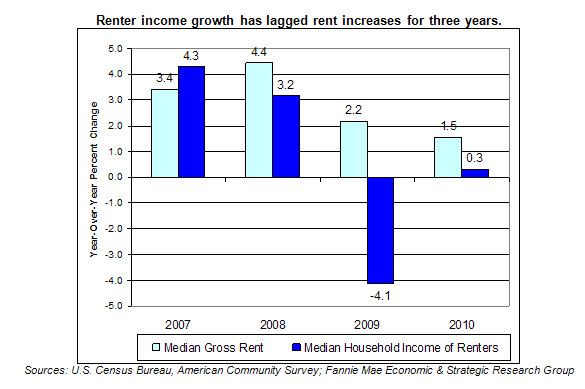As Renter Incomes Stall, Rental Affordability Problems Mount

For several years, housing market conditions have been bleak, with only the rental market showing recent signs of recovery. Rents have increased, vacancy rates have fallen, and multifamily construction has begun to climb out of its deep recessionary hole.
Unfortunately, recent rental market developments also have included an increase in renters with housing affordability problems. A new Data Note from Fannie Mae’s Economic & Strategic Research Group uses the Census Bureau's American Community Survey to show that the proportion of renters experiencing "housing cost burdens" (i.e., paying at least 30 percent of income for housing) expanded from 49.8 percent to 53.0 percent between 2006 and 2010 (see chart below). The proportion of renters with the most severe affordability problems – those spending at least half of income for housing – increased from 25.1 percent to 27.4 percent during this period. In contrast to the worsening rental affordability situation, the proportion of owner-occupants with housing cost burdens has remained stable.

The expansion of rental cost burdens has been widespread. Rent burdens have increased for young- and middle-age households and for all housing structure types, including the rapidly growing single-family rental segment (see Data Note: Single-Family Rental Housing – The Fastest Growing Component of the Rental Market). Furthermore, between 2006 and 2010, 35 states experienced statistically significant increases in the rate of rental cost burdens, whereas none experienced a significant decline. Rental affordability problems have grown particularly rapidly in the southeastern United States, a region that also has been hit hard by falling homeownership (see Data Note: A Bad Decade for the American Dream).
A decline in renter incomes during the Great Recession that exceeded a deceleration in rents has been the principal factor behind the rise in rental cost burdens. Rent growth for the entire renter-occupied stock has outpaced renter income gains by a substantial margin in every year since the onset of the economic downturn (see chart below).1 In 2009, during the depth of recession, rent increases remained positive while renter incomes contracted sharply. Although renter incomes have returned to slow growth during the economic recovery, they still lag rent increases by a substantial margin.

The rise in rental cost burdens has two potential implications. First, the sharp slowdown in renter income growth suggests that a strong economy that supports household income gains might help to slow or reverse the increase in rent burdens. Second, if the increase in rent burdens across housing structure types that was observed between 2006 and 2010 continues, then preserving and expanding the stock of both single-family and multifamily affordable rentals might offer one approach for addressing rental affordability problems.
1 It is important to note that the rent increases depicted in the chart apply to all renter-occupied housing units with cash rent, regardless of building size or quality, and are not limited to institutional investment-quality multifamily properties.
Doug Duncan
Chief Economist
Vice President
May 7, 2012
Opinions, analyses, estimates, forecasts and other views of Fannie Mae's Economic & Strategic Research (ESR) Group included in this commentary and related Data Note should not be construed as indicating Fannie Mae's business prospects or expected results, are based on a number of assumptions, and are subject to change without notice. How this information affects Fannie Mae will depend on many factors. Although the ESR Group bases its opinions, analyses, estimates, forecasts and other views on information it considers reliable, it does not guarantee that the information provided in these materials is accurate, current or suitable for any particular purpose and this information does not constitute investment advice. Changes in the assumptions or the information underlying these views could produce materially different results. The analyses, opinions, estimates, forecasts and other views published by the ESR Group represent the views of that group as of the date indicated and do not necessarily represent the views of Fannie Mae or its management.
The views expressed in these articles reflect the personal views of the authors, and do not necessarily reflect the views or policies of any other person, including Fannie Mae or its Conservator. Any figures or estimates included in an article are solely the responsibility of the author.
